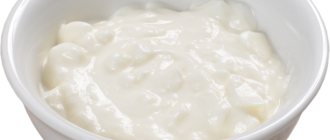All articles by the author
Author of the article: Maxim Fadovsky
Healthy and healthy lifestyle specialist.
Olives have relatively recently become a frequent guest on the Russian table. They managed to win both ardent supporters and opponents. The latter say that harmful dyes are added to canned olives, and you can only eat green olives, but they are of little use.
Canned olives bring benefit or harm to the body, as well as how olives and olives actually differ - this will be discussed in this article.
How are they good for the body?
To find out why olives are useful, you should take a closer look at their composition, which is a real storehouse of useful substances. It is not for nothing that this product is recommended as a preventative to absolutely all people.
Compound
The chemical composition of olives includes many useful substances. First of all, the fat content is striking - 23.9%. 100 grams of fresh olives contain 39.8% of your daily value (DV) for fat.
These fats contain:
- 15.1 g oleic acid;
- 3.6 g linolenic acid.
Other acids are contained in small quantities. Oleic acid is a monounsaturated fatty acid and plays an important role in fat metabolism.
Carbohydrates in olives: 19 g (9% DV). Of this, 4 g is fiber, which is not digested in the intestines, but stimulates its peristalsis and normalizes the intestinal microflora. 4 g of fiber covers the daily requirement for it by 20%.
There is very little protein - 1.6 g or 2.1% DV.
Of the vitamins, olives contain the most vitamin E, which is very important for maintaining reproductive health in both women and men. Its content is 5 mg per 100 g of olives or 33.3% of the DV.
Olives of varying degrees of ripeness
There are also noticeable amounts of vitamin A and its provitamin, carotene (3.7% and 4% DV, respectively). Very little vitamin PP (1% DV), and very little of the rest.
There are many minerals:
- sodium (350 mg, 26.9% DV);
- calcium (70 mg, 7% DV);
- magnesium (25 mg, 6.3%).
There is potassium (95 mg, 3.8% DN) and phosphorus (20 mg, 2.5% DN), iron (0.5 mg, 5% DN).
Of the microelements we note:
- copper (0.2 mg, 10% DN);
- zinc (0.2 mg, 2% DV);
- selenium (0.9 µg, 4.5% DV).
Calorie content 100 grams
Calorie content of 100 grams of olives is 296 kcal (17.6% DV). This value is average. The calorie content of olives changes as the fruit ripens. Knowing how many calories are in olives is necessary for those who are on a diet and want to lose weight, since their energy value is very high.
Canned pitted olives have slightly less calories. Their energy value is 140-175 kilocalories per 100 grams. But for those olives that were marinated with the pit, it is a little larger. After all, naturally ripened fruits are pickled with it, while those canned without it get their dark color artificially. It is difficult to remove seeds from ripe fruits without damaging the integrity of the fruit, which is why they are not removed.
Useful properties for women
Olives and olive oil should be included daily in your diet. The benefits of olives for women's health include normalizing the synthesis of estrogens and gestagen (female sex hormones) and improving the functioning of the reproductive system,
The beneficial properties of olives are determined by the fact that they contain oleic acid, which gets its name from them. This monounsaturated fatty acid belongs to the omega-9 acids. It is not essential, and if there is a lack of it in food, it is synthesized in the body. But natural products are much more useful, since with them a person receives a whole complex of biologically active substances, which enhances the properties of individual components. Olives contain a lot of tocopherol - vitamin E, phytosterols and selenium, which work together with oleic acid.
It has long been noted that residents of Greece, Spain and Italy suffer much less often from heart attacks, diabetes and cancer, especially breast cancer. This is explained by the fact that there are a lot of olives and olive oil in the diet, and it is oleic acid that protects against these terrible ailments.
But the benefits of olives for women are not limited to cancer prevention. A lack of oleic acid manifests itself in dry hair, skin and mucous membranes. Olives help maintain youth for many years, as they make the skin elastic, hair thick, and nails beautiful. Olive oil is included in many cosmetic products.
Usefulness for men
Canned olives are also good for men, who also need vitamin E, zinc, oleic acid and selenium. Men of working age are much more likely to suffer from diseases of the cardiovascular system: atherosclerosis, coronary artery disease, myocardial infarction and stroke.
Olives have minor anti-ischemic, vasodilating and antiplatelet properties. These effects, when used systematically, have been proven to reduce the risks of the diseases listed above.
Useful properties of olives
Olives have a beneficial effect on the body. Due to their high content of fatty acids, vitamins and minerals, they are used in the treatment and prevention of a number of diseases:
- Phosphorus and calcium help strengthen bone tissue, which helps improve the patient’s condition with gout, arthritis and arthrosis.
- Vitamins B and C regulate metabolism. Olives are low-calorie foods. They are great for helping you lose excess weight.
- Fatty acids help children's bodies grow. Together with fiber and vitamins B, C and E, they speed up metabolism and lower blood sugar levels.
- Vitamins C and E have a strengthening effect on the immune system, so the product is indicated for colds and viral infections.
- Fiber speeds up digestive processes and eliminates gastrointestinal disorders.
- Black olives contain a large amount of iron. Vitamin C helps its absorption. Regular consumption of this product helps increase hemoglobin in anemia.
- Potassium, vitamins PP and B6 normalize blood pressure, increase the elasticity of blood vessels and cleanse the blood of cholesterol plaques.
- For neurotic disorders, the fruits improve blood supply to brain tissue, have a slight calming effect, and strengthen the central nervous system.
For men
For men, olives are considered a healthy product. Zinc increases the production of the male hormone - testosterone. Vitamin B9 fights patchy baldness and stimulates the growth of new hair. B6 increases blood circulation.
Fatty acids cleanse blood vessels and improve erection.
Vitamin E is responsible for sperm quality. It prevents the destruction of testosterone by insulin.
For women
Most often, women use olives for weight loss, as they are low-calorie foods. Unsaturated fats, vitamins A and E increase a woman's fertility and increase the chances of conceiving a child.
Phosphorus and calcium strengthen nails and improve the condition of teeth. Vitamins A and B reduce the formation of wrinkles, give the skin a healthy glow, and hair – thickness and shine.
Selenium together with vitamin E reduce the risk of cancer.
During pregnancy
Vitamin B6 helps thin the blood, strengthens the walls of blood vessels and prevents thrombosis, which is important during pregnancy. At the same time, the quantity of products consumed should be limited: 5-10 pieces are enough. every 2-3 days.
When breastfeeding
Olives can be included in a woman’s diet 1 month after giving birth. Since the fruits contain a large amount of unsaturated fats, they should be consumed up to 5 pieces. in a day.
Is there any harm from using it?
The benefits are clear, but can olives cause harm to the body? The daily norm is no more than 100 g of green and black olives with pits and 50 g of black ones without pits.
If you consume only olive oil, the body will be harmed, since omega-6 unsaturated fatty acids will not be supplied enough, and omega-3 will not be supplied at all. Therefore, the usefulness of olives and olive oil will increase if you supplement them with nuts and seafood, as well as fatty sea fish. Can you fry in olive oil?
Recommendations for use
To get all the beneficial properties from olives, it is enough to eat 7-10 pieces a day: you can eat them in their pure form or add them to salads and soups. You do not need to add salt to dishes with salted and canned fruits. Green olives are a great appetizer for white wine. They go well with cheese and vegetables. In cooking, they are also often used to decorate dishes.
Here are some simple and interesting recipes with these fruits:
Greek salad
A classic recipe that is loved all over the world. It will require the following ingredients: 2 cucumbers and tomatoes, 1 sweet pepper and red onion, 150 g olives, 100 g Feta cheese, a teaspoon of oregano, two tablespoons of olive oil.
The salad does not require heat treatment . All you have to do is chop, mix and season the ingredients. Cut tomatoes into cubes, onions into half rings, olives into circles. The components can be simply mixed or laid out in layers. First go the cucumbers, then add a small amount of salt and oil. Then add peppers, onions, tomatoes, olives and cheese. Now mix the oil and oregano and add it to the salad. Many people prefer not to mix olive fruits, but to put them whole in the salad.
Avocado salad
An easy and very piquant salad recipe for which you will need the following ingredients: 2 avocados, 1 onion, 1 orange, 30 olives, 1.5 tablespoons of wine vinegar, 5 tablespoons of olive oil, salt, red pepper to taste.
Peel and slice the orange and avocado, chop the olives and remove the pits. Cut the onion into half rings. Mix everything. Prepare the dressing: mix vinegar, oil, salt, mustard, red pepper. Pour it over the salad.
Find out what other dishes you can prepare with olives from this video:
Are there any benefits from canned olives?
The benefits of canned olives are the same as those of fresh ones. It’s just impossible to eat them fresh without soaking them for months due to their inherent bitterness. And the canned ones underwent a similar procedure quickly. To do this, they are treated with caustic soda, and if they want to get a dark color, oxygen is passed through.
In the latter case, the color is fixed with iron gluconate. Caustic soda is neutralized during the pickling process. The content of nutrients will decrease slightly. The amount of sodium, of which there is already a lot in olives, increases. Therefore, hypertensive patients should not rely heavily on them.
Oleic acid lowers cholesterol and improves the lipid composition of blood cells, strengthens blood vessels and the heart, reduces the acidity of gastric juice, and normalizes intestinal function. It exhibits medicinal properties for gastritis, osteochondrosis, atherosclerosis, thrombosis, and arthritis.
Oleic acid is not all that is good for canned olives, which contain tocopherol, iron, calcium and magnesium, zinc and copper.
People with a diseased liver or stomach should prefer green olives or olives with pits, which do not contain iron gluconate. Although in the amount contained in 50 g of olives, it is beneficial - it stimulates hematopoiesis and increases hemoglobin levels. Cereals, fresh vegetables, and egg yolk slow down the absorption of iron gluconate.
Use of olives
The fruits are widely used in various industries. In cooking, pickled or dried olives are most often used. Finished products differ in quality and price category.
Olives produce oil, which is in great demand. It is nutritious and healthy. They produce both a refined product and a first-pressed one, which allows you to preserve all the beneficial properties of olives.
Olives are widely used in cosmetology. They are included in many skin and hair products: shampoos, masks, balms, creams and cleansing tonics.
Traditional medicine also uses recipes with the addition of olives. They are used to prepare remedies for many diseases.
At home, you can prepare a mask for dry skin with the addition of olive oil. It will restore the water balance of the epidermis, remove fine wrinkles and refresh the skin. To prepare it you need to take 5 ml of extra virgin olive oil and 0.5 tsp. freshly squeezed lemon juice. Mix the ingredients and apply a thin layer to the face. After 10 minutes, the mixture can be washed off. After the mask, it is recommended to apply a nourishing cream.
With the addition of olive oil, it makes an excellent body scrub. It deeply exfoliates dead skin particles and has an anti-cellulite effect. To prepare the product, you need to mix finely ground sea salt, olive oil and the juice of one lemon in a 1:1:1 ratio. Before using the scrub, it is recommended to steam your body in a hot bath. The product is rubbed into the skin with light massage movements. Then rinse off with warm water.
During the procedure, slight tingling or pinching of the skin is possible. This is considered normal - this is how mustard affects the epidermis, stimulating the growth of hair follicles. If severe irritation occurs, it is recommended to wash off the mixture. After the procedure, the mask is washed off with warm water and shampoo.
In folk medicine
Traditional medicine uses olive oil, fresh fruits and leaves for therapeutic purposes.
For a severe dry cough, take 30 ml of extra virgin olive oil, 10 g of natural honey and 1 egg yolk. The components are mixed until smooth using a whisk or mixer. The mixture is consumed twice a day, 0.5 tbsp. l. in a week.
For the treatment and prevention of hypertension and atherosclerosis, 40 g of dry olive leaves are poured into 1 liter of boiling water. Leave for 3 hours. Drink 20 ml three times a day 20 minutes before meals.
To remove an abscess or small ulcerative erosion, 5 fresh fruits are ground to a paste. Add 1 tsp. 9% vinegar. The mixture is applied once a day to the area with the formation.
For swelling, brew 1 tbsp. l. crushed olive leaves in 250 ml of water. The decoction is taken 3 times a day before meals. Treatment is stopped after complete recovery.
The most common misconception about olives is that black olives are a different type of plant, taken from different trees. Also, some believe that olives are olives stained with chemicals and therefore more harmful.
Important! Olives and olives are the same fruits, taken from the same tree, but undergo different technological processing. Moreover, the concept of “olives” is used only in the territory of the former USSR; in Europe they are called black olives.
Fresh olives are not suitable for use as snacks - they are very bitter. Therefore, a canned product is used in most cases; it differs only in manufacturer and quality. And fresh fruits are used only for the extraction of healthy oil.
Peculiarities of growing olives This tart delicacy grows in southern Europe and Asia, as well as in Africa. The olive tree is an evergreen plant from the olive genus. The fruits are collected before they ripen and sent for preservation. Fresh snacks are harder than canned ones and differ in color - ripe fruits are brown and dark purple.
The methods of harvesting the plant also differ: unripe olives are collected by hand and placed in baskets, while ripe ones are simply shaken from the tree onto hammocks stretched near the ground.
How do olives turn black? The marinade gives the fruit its dark hue. Before preservation, they undergo calibration: some of the fruits are sent to the marinade immediately so that they retain their natural shade, the rest are sent to canisters, where they lie under compressed air for 10-12 days and become black.
First, the raw materials are stored in large tanks connected to each other and located underground to maintain a constant temperature. For further processing, the fruits are pumped out with an air pump and processed: seeds are removed and stuffed. At the same stage they undergo calibration. You can find crayons and large olives on sale.
Misconceptions There are 4 misconceptions regarding black and green olives:
- Black ones contain less nutrients. When processed the same way, both types retain the same amount of minerals, vitamins and fatty acids.
- Black ones contain more dyes and preservatives. There is actually no food coloring added to the brine.
- Blacks have too much iron gluconate. During oxidation, compressed air is supplied to the tanks, as well as less than 1% iron, which improves the blackening of the olives. It is safe for health.
- Black olives are riper. In fact, black and green appetizers have the same degree of ripeness. Their hardness is regulated by different concentrations of salts in brines.
Thus, black and green fruits are the same in the content of nutrients, ripeness and quality. However, they differ in color, brine composition, processing technology and consistency.
olives and black olives - what's the difference?
Olives and black olives are synonyms of the same variety and also grow on the same tree. The difference is that the first of them are green fruits, and the second are ripe. The color of olives is affected by their level of ripeness. Green fruits are very hard, which is explained by the low amount of oils they contain. Once fully ripe, the berries become dark purple in color and their flesh becomes wrinkled.
We invite you to familiarize yourself with Aralia honey beneficial properties
Green fruits are collected by hand into special baskets. Ripe olives fall on their own into baskets, which are pre-installed under the trees. After harvesting, the fruits are sorted according to size. The berries are placed in a special solution with caustic soda, which eliminates bitterness.
Natural olives are expensive, so many people produce them themselves. After picking green berries, they are placed in a container to which oxygen is supplied, which leads to oxidation. To obtain a dark color, a special dye is added.
How and where do they grow?
Almost everyone who has been to the Mediterranean, Crimea or Abkhazia knows how and where olives grow. Olive trees now grow throughout tropical and subtropical climates: in East Asia, Australia, Peru, Azerbaijan and Turkmenistan, Iran and Mexico. The olive is an amazing tree that lives up to 2000 years.
According to legends, the olive is immortal, so its fruits make people hardy and resilient.
People have been familiar with it for 5.5 thousand years. This is evidenced by stones for squeezing oil and vessels for it in the archaeological layers of those times. A dove brought an olive branch to Noah. The other was given by Athena to the city that bears her name from ancient times to the present day. It was also brought by a dove to Mary in the Gospels.
This is a powerful tree with a thick trunk and lush crown. Olives bloom in April-July with panicles of 10-45 fragrant white flowers. The harvest is harvested from early autumn to January. The olives are immediately taken for processing so as not to lose their presentation.
Olive Tree
Interesting facts, myths and legends about olives
Canned and fresh olives are one of the first products to be grown by humans. There are images of this product on ancient Egyptian vases and amphorae, and the ancient Greeks associated it with the goddess of wisdom, Athena.
Fact! People began to grow the first olive trees in Crete 3000 BC.
The olive tree can live more than 2000 years. In Israel, these trees bloom on the Mount of Olives. The average lifespan of a plant is 500 years.
Up to 90% of the olive harvest is used to produce refined and unrefined oil. And trees are grown for export mainly in the Mediterranean region.
Canned olives are an affordable, tasty and healthy product when consumed in moderation. However, even its hypoallergenicity does not give people with chronic diseases the right to add olives to their diet without consulting a doctor. Choose the right products, store them according to requirements and enjoy the tart taste!
Can you eat olives while breastfeeding?
Which color is better - black or green?
The debate about which olives are healthier - black or green - has not subsided since they began to be massively imported into our country. The differences between them are much smaller than the similarities.
Let's look at the benefits of green olives. They contain slightly more fat than black ones, as well as vitamin E, 4 times more potassium and 3 times more magnesium. This composition determines the healing properties of olives for diseases of the heart and blood vessels, and also helps fight fatigue. Their benefits are noticeable and the next morning after a stormy feast, green olives will quickly bring you back to normal.
Let us now find out why black olives are beneficial. They have fewer calories, but more calcium, iron and zinc than green ones.
Therefore, the benefits of black olives are undeniable for anemia, weakness, and sexual dysfunction.
Summarize
Olives are rich in phytonutrients and are known to provide the body with antioxidants, lower cholesterol and high blood pressure, relieve pain, treat and prevent cancer, promote heart health, work as a natural probiotic, reduce the risk of diabetes and obesity, help fight infections and prevent osteoporosis.
The difference between fruit and oil is preparation and processing. Canned olives have higher levels of sodium and less fat, and olive oil has higher amounts of beneficial polyphenols.
Olives are high sodium foods. Also, as with most foods, consume them in moderation.
Olives are actually a stone fruit and not a vegetable or berry. Stone fruits are characterized by a hard central stone surrounded by pulp that contains a seed.
Tags: Olives
- Related Posts
- Dried apricots: benefits and harm to the body, how much to eat
- Persimmon: benefits and harm to the body, contraindications
- Apricot and peach: what's the difference?
« Previous entry
What is the difference with olives?
Both olives and black olives grow on the same tree, and only in Russia are they distinguished. When asked what color the olives are, they will confidently say that they are green. Of course, because black ones are called olives, and green ones are called olives.
In the rest of the world, both are called olives.
They say that GOSTs are to blame for this. When the first batches of canned olives arrived in Russia, someone wrote down green fruits as olives, and black fruits as olives. This seems to be where the division began.
Branch with ripe olives
Potential dangers, contraindications of green berries
Both olives and black olives are practically safe for the body, but individual intolerance to the product is possible. Peculiarities:
- The composition contains fats, so excessive consumption of the product can lead to excess weight, especially in combination with high-calorie foods.
- For those who suffer from stones in the gall bladder or kidneys, olives can provoke the movement of formations.
- An allergy is possible, which does not appear immediately, but after some time.
- Expired or low-quality canned food is the cause of severe poisoning.
- These fruits do not combine with many foods. This, for example, includes all fermented milk products, except cheese.
- Olives are not fried, since such heat treatment produces substances that are harmful to our health. Baking them is also not recommended.
- Artificially colored berries are dangerous.
You will learn even more about the health benefits and potential harm of olives from the popular program “About the Most Important Thing”:
Contraindications
Despite the abundance of beneficial properties, there are also contraindications to eating olives. This is an allergy to them, fortunately, which is quite rare. You need to be very careful with them and patients with pancreatitis and cholecystitis. Their consumption should be strictly limited, and in case of exacerbation it should be completely eliminated. For gastritis with high acidity, kidney stones and cystitis, eating large amounts of olives can also be harmful. The first time the child should be given one or two olives to make sure that there are no allergies or individual intolerances.
Can olives be consumed by pregnant and nursing mothers?
The benefit of olives for pregnant women is determined by the fact that they are able to replenish the significant loss of sodium salts during this period. When consuming berries, the water-salt balance is completely restored and the general condition of pregnant women is improved.
The benefits and harms of dried olives are determined by their method of preparation. The berries are dried in the sun. That is why they do not include harmful preservatives and salts.
The benefits of fruits are very great for nursing mothers, as they improve the quality of breast milk. Fatty amino acids are the building blocks for the skin. They ensure the production of sex hormones and have a positive effect on the immune and vascular system.
Magnesium, which is part of the fruit, has a positive effect on the nervous system of the mother and child. Calcium ensures complete formation of bone tissue.










